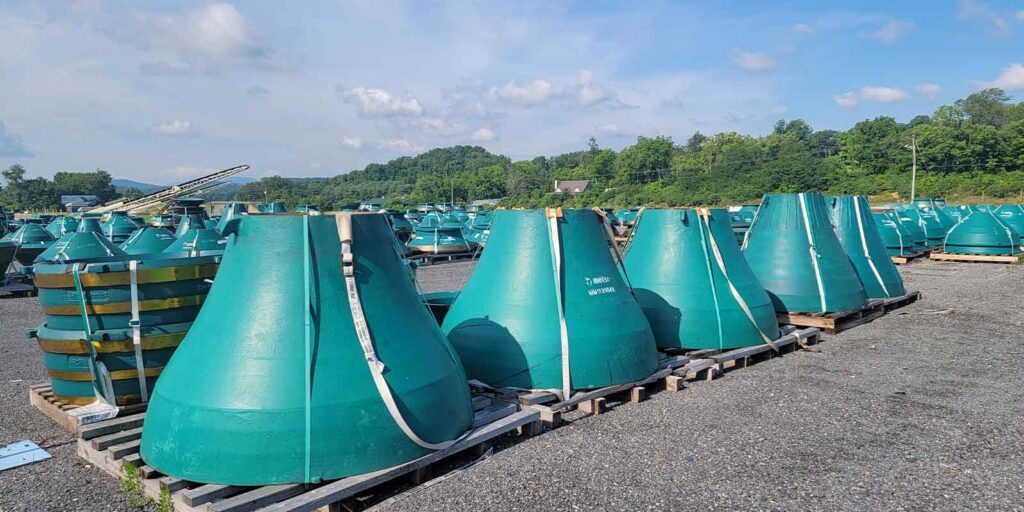Rock crushers are an integral part of any aggregate operation, providing the necessary materials needed for a wide range of construction and maintenance tasks. However, just like any mechanical system, wear can occur over time due to harsh working conditions and the impact of rocks on the machinery. Crusher wear parts can become worn prematurely if left unchecked, leading to costly repairs over time. In order to avoid these expensive roadblocks, it is important to handle your maintenance protocols properly.
Types of Rock Crushers
Rock crushers are machines that reduce large rocks into smaller, more manageable pieces. Various types of rock crushers are available on the market today, ranging from large primary jaw crushers to smaller, secondary impact crushers, and even tertiary cone crushers. Each type of rock crusher is designed for a specific application and can vary in terms of size, power, and efficiency.
Primary Jaw Crushers
Primary jaw crushers are typically used to reduce large chunks of material into smaller pieces. They can be effective in mines and quarries for larger material reduction or as part of a processing plant for crushing raw material prior to further processing. These powerful machines use specialized jaws with an oscillating motion that crushes the rock against a fixed surface or stationary plates.
Secondary Impact Crushers
Secondary impact crushers use a rotating hammer to break down materials after they have been run through primary jaw-crushing machines. The hammers are designed with different sizes of heads depending on the desired output size and can range from flat-faced hammers to round-headed ones. These machines produce particles with a more cubical shape when compared to primary jaw crushers. Secondary impactors are ideal for producing higher quality aggregates like gravels and asphalt products, while also being able to crush softer stones like limestone and sandstone quicker than primary jaw machines.
Tertiary Cone Crushers
Tertiary cone crushers are designed to produce smaller particle sizes than those produced by secondary impactors. Cone crusher technology uses a spinning cone inside an outer chamber lined with wear-resistant steel concaves that spin against one another within an inner compartment lined with hardened steel mantles to break down materials at high speeds and pressures. This results in uniform product shapes with fewer flats or slivers when compared to other types of rock-crushing equipment.
Why Rock Crusher Parts Wear Prematurely
Depending on the application, each type of rock crusher has its own unique set of worn parts that must be replaced regularly in order for the crusher machine to continue operating effectively.
With continued usage, crusher wear parts will begin to degrade due to exposure from abrasive materials as well as the inevitable pressure placed upon them during operation-leading them to eventually need replacement prematurely if preventive maintenance is not kept up with. By understanding what causes premature crusher wear, it can be much easier to ensure you are able to maximize the equipment’s lifetime value moving forward.
Using high-quality spare parts and taking steps to reduce wear can help to prolong the lifespan of your rock crusher, minimizing premature wear and maximizing productivity. Here are a few tips on how to minimize premature wear on your rock crushers:
-
- Regularly inspect rock crushers for signs of excessive wear or damage. This includes checking for worn bearings, seals, belts, liners, and other components that may be wearing out more quickly than usual. Addressing small problems will stop them from becoming larger issues in the future.
- Ensure that you’re using crusher parts made from premium materials. High-quality crusher parts are designed for maximum durability and will last longer than parts made with inferior materials.
- Improve the lubrication process in your crusher by using a lubricant specifically designed for heavy machinery. This can help improve the efficiency of operation by reducing friction between parts which reduces heat generation. This also helps extend the equipment’s life span by preventing excess wear caused by overheating or improper lubrication techniques.
- Always feed material into your crusher at a slow and steady rate. This ensures that no overloads occur which can cause rapid wearing of components as well as poor performance due to insufficient power.
- Keep crusher parts clean. Regularly cleaning away dust, dirt, or any other debris that may be impacting performance or causing excess friction between moving parts can reduce the amount of wear and tear experienced over time.
Save Time and Money by Adhering to Proper Maintenance
Ensuring that you are performing the proper maintenance on your machinery is essential for protecting your investment and promoting operational efficiency. By understanding the causes of premature crusher wear, you can take steps to prevent this from happening in the future. Regularly inspecting and maintaining your crusher parts will help reduce downtime, increase efficiency, and maintain a safe working environment. Investing in high-quality crusher parts is also an important part of extending their lifespan and avoiding costly repairs or replacements down the line. With these tips in mind, you will be much better equipped to keep your rock crusher running at peak performance.
For more information on rock crushers and how to properly maintain them, reach out to the Mellott team of experts today at 855-554-1606.

